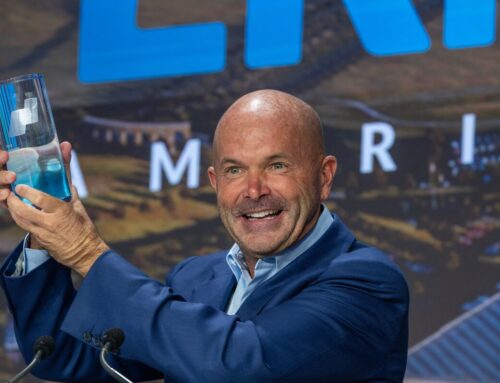You’re Not Imagining It: Your Pollen Allergies Are Lasting Longer
April 12, 2025
From our collaborating partner “Living on Earth,” public radio’s environmental news magazine, an interview by producer Aynsley O’Neill with Dr. Neelima Tummala, an ear, nose and throat physician at NYU Langone Health.
We are in the middle of sniffling season.
In the Southeast, the yellow mist of pollen might have peaked already. But for the millions of allergy sufferers in the colder parts of the country, the season of misery will be around for a while. And scientists believe that our warming climate is intensifying seasonal allergies.
With warmer weather, plants are blooming earlier, and an increase in atmospheric carbon dioxide levels prods plants to step up pollen production. Altogether, it means that allergy season arrives earlier, ends later and produces more pollen throughout.
Dr. Neelima Tummala is an ear, nose and throat physician at NYU Langone Health who has written extensively on the impact of climate change on our allergies. This interview has been edited for length and clarity.
AYNSLEY O’NEILL: Let’s take this year’s allergy season and compare it to one from, say, 20 years ago or 50 years ago. What’s the difference between allergy seasons now and the allergy seasons of the past?
NEELIMA TUMMALA: The allergy season has changed, and a big reason for that change is that the environment that we are living in on a day-to-day basis is different now than it was 50 years ago.
Because of global warming, temperatures have risen as compared to pre-industrial times, and with those changes in temperatures, there’s also been some changes in precipitation patterns, and these environmental changes have affected the pollen allergy season specifically.
What the data shows is that the pollen allergy season on average in the United States is about three weeks longer now than it was 50 years ago. Usually tree pollen is an issue in the spring. And then in the fall, the pollen is lasting longer, so that’s usually ragweed pollen. The reason for that is when we have warmer temperatures, the ground thaws earlier in the year, so this allows the trees to grow earlier. Then the ground doesn’t freeze as quickly in the fall, so the pollen lasts longer.
Another difference we’re seeing now compared to 50 years ago is that there’s a lot more pollen in the air. The data shows that there’s about 20 percent more pollen in the atmosphere in the United States than there was 50 years ago. This, again, is related to some of the impacts that we’re seeing from global warming and increased carbon dioxide, one of the main greenhouse gases that is warming the planet, and how that impacts the ways that trees and plants grow.
O’NEILL: What’s the implication for public health when it comes to having a longer allergy season?
TUMMALA: There are a couple of different things I am really concerned about as a physician who’s treating patients with pollen allergy symptoms.
The first is, how is this impacting quality of life? For anyone who has pollen allergies, it’s not fun. About 20 percent of Americans have pollen allergies, so this increases the amount of symptoms that patients have to deal with. This includes the nasal congestion, sneezing, itchy, watery eyes, the runny nose—all of those symptoms are starting earlier and lasting longer. So basically, it’s just having to deal with these symptoms that impact our quality of life, impact our sleep efficacy, impact our ability to pay attention during the day for longer throughout the year.
The second issue is, when there’s more pollen in the air, the symptoms themselves are likely to be more significant.
If you’re dealing with more pollen, then that’s going to be more of an issue in terms of how much it’s irritating and causing inflammation inside the nose and causing worsening symptoms than you used to have.
In order to control these symptoms, a lot of times, people have to adjust their allergy medications, and this may include starting your allergy medications earlier in the year and using them longer in the fall, or potentially even increasing the amount of allergy medications that you’re using. These are going to have a direct impact on your wallet. You have to pay more for medication to be able to control your symptoms, and so there is definitely concern for the economic impact this is having on anyone with pollen allergies.
O’NEILL: To what extent are seasonal allergies just some sort of unfortunate annual discomfort, versus something that could be more serious?
TUMMALA: For some people, pollen allergies are more of a bothersome thing. They might have very mild pollen allergies, so they’ll feel a little bit of sneezing or congestion.
There are some people whose allergies are much more severe; they have a much stronger reaction to it. For some people, allergies can trigger asthma attacks. That’s called allergenic asthma, so it’s not just dealing with the nasal symptoms, the itchy, watery eyes: It can also impact your breathing. Those are some of the really concerning sequelae of pollen allergies. How is it impacting your breathing?
O’NEILL: Beyond your typical over-the-counter or even prescription allergy medications, what are some tips you would give to pollen sufferers when they’re going through these seasonal allergies?
TUMMALA: There are a couple of different things that can be helpful when you’re thinking about avoiding the impacts of pollen allergies. One of the first things is, how do you protect yourself from pollen exposure?
One way is to check the pollen levels, and on days where the pollen levels are really high, try to minimize the amount of outdoor exposure that you have. You can also wear a mask when outdoors, because that will definitely help mitigate the amount of pollen that you’re exposed to.
We also know that right now, we’re going through tree pollen. The highest levels tend to be in the morning and the afternoon, so maybe choosing to be outdoors more in the late afternoon or evening, you’ll probably be exposed to lower pollen levels.
When you come back home from being outdoors, it’s really helpful to change your clothes or shower if you’re out with your pet. Keeping your windows closed when you’re driving your car or when you’re at home will definitely help prevent pollen from getting in the home. Those are some tactics just to avoid the pollen exposure itself.
The next level is, if you are exposed to these pollen levels, then how do we protect ourselves from them? That’s where the allergy medications come into play. There are both nasal sprays and eye drops and oral allergy medications that you can take. And these definitely deserve a really good discussion with your allergist or ENT physician to talk about what’s going to be an ideal regimen for you to control your symptoms.
The third area that we think about is if these interventions aren’t enough, or if someone just really wants to see what else can be done, that’s when allergy immunotherapy can be helpful. This is a conversation you’d have with your allergist or ENT physician to say, could allergy shots be helpful for me when I’m dealing with my pollen allergy symptoms?
O’NEILL: Beyond a seasonal allergy, how is climate change affecting life for allergy sufferers generally?
This story is funded by readers like you.
Our nonprofit newsroom provides award-winning climate coverage free of charge and advertising. We rely on donations from readers like you to keep going. Please donate now to support our work.
TUMMALA: Another way that global warming is impacting anyone who has environmental allergens is its impact on extreme weather events like flooding and hurricanes. With global warming, climate scientists have shown that extreme weather events like flooding and hurricanes are definitely more intense, and the frequency of some of these extreme weather events has increased.
One of the big concerns is the water that’s left after these events and the increased risk of mold growth and mold exposure. Mold is a really common environmental allergen as well, so anyone who’s been in a home that has been flooded or has had to deal with standing water, the mold exposure is definitely something that we also want to be conscientious of, and definitely make sure that we address that both from cleaning the mold standpoint, but also from protecting ourselves from the allergy symptoms associated with it.
O’NEILL: What do you see as the importance of addressing our changing climate from a healthcare perspective?
TUMMALA: Addressing changes in climate is incredibly important from a healthcare perspective. Climate change itself has had a huge impact on public health, both here in the United States and globally, and it is one of those public health concerns that’s going to continue to get worse unless we do something about it.
It is about avoiding exposure and changing your medications, avoiding being outdoors at certain times. All of that is really important.
But what we also need to do is make the environment that we live in a healthy environment. We can’t expect to be as healthy as we want to be if we live in an environment that is not healthy.
So one of the major things that we really need to do is transition off of fossil fuels that are contributing to emissions that are warming the environment. They’re contributing to global warming.
We need to improve air quality. We need to make sure that the water everyone is drinking is clean.
All of these things are really essential to making sure that the environment that we’re living in is healthy, so that we can all be healthy. At the root of all of this is really addressing the cause of these health concerns, and that’s climate change. That’s why climate action is so important for improving public health.
About This Story
Perhaps you noticed: This story, like all the news we publish, is free to read. That’s because Inside Climate News is a 501c3 nonprofit organization. We do not charge a subscription fee, lock our news behind a paywall, or clutter our website with ads. We make our news on climate and the environment freely available to you and anyone who wants it.
That’s not all. We also share our news for free with scores of other media organizations around the country. Many of them can’t afford to do environmental journalism of their own. We’ve built bureaus from coast to coast to report local stories, collaborate with local newsrooms and co-publish articles so that this vital work is shared as widely as possible.
Two of us launched ICN in 2007. Six years later we earned a Pulitzer Prize for National Reporting, and now we run the oldest and largest dedicated climate newsroom in the nation. We tell the story in all its complexity. We hold polluters accountable. We expose environmental injustice. We debunk misinformation. We scrutinize solutions and inspire action.
Donations from readers like you fund every aspect of what we do. If you don’t already, will you support our ongoing work, our reporting on the biggest crisis facing our planet, and help us reach even more readers in more places?
Please take a moment to make a tax-deductible donation. Every one of them makes a difference.
Thank you,
Search
RECENT PRESS RELEASES
Related Post



